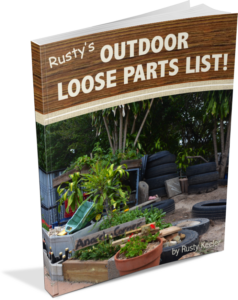West St. Paul, Minnesota
written by :: Staff of the Dodge Nature Preschool

How did the Dodge Nature Preschool start?
It was founded in 2000 on the grounds of Dodge Nature Center, a nature preserve and environmental learning center serving school children and the community since 1967. The Center’s mission is to be a place where people can experience, study, and enjoy the natural environment and in so doing, become inspired stewards of the natural world. The Center’s Board of Directors envisioned the creation of the preschool as one way to bring in new members and expand the community that the Center serves.
The Preschool’s mission is to meet children’s developmental needs while initiating them into a lifelong, meaningful relationship with the natural world. We believe that the appeal of the natural world is universal and powerful, and that there is no better environment or curricular foundation for early childhood education.
At Dodge Nature Preschool we are guided first and foremost by best practices and guidelines developed by the National Association for the Education of Young Children.
How do you plan activities?
Our first consideration in any endeavor, whether it is setting up a classroom or planning a hike or outdoor experience, is the developmental level of the children in our classroom. Because we have mixed-age classes, some children will not be ready for lengthy discussions or explanations from adults, and others will be fascinated by group interactions and discussions. We attempt to balance the needs of the children in our classes, and by placing three teachers in each class we can better meet those individual needs.
At an early age children perform experiments to discover how things work. Jean Piaget, a Swiss developmental psychologist, described twelve- to eighteen-month-old children as ‘little scientists.’ Babies learn about the world by placing objects in their mouths. Toddlers experiment with cause and effect, such as throwing a spoon from a high chair and watching it fall. Most toddler experiments are based on trial and error. Preschoolers can be more purposeful in their experimentation. Teaching young children to be purposeful experimenters helps them to make sense of the world and organize their thinking about the natural world. As research supports, learning the scientific method helps children develop confidence in their ability to predict and control their experiences and, in the long run, encourages them to become more deliberate people with a greater sense of responsibility.
 Children’s observations outdoors contribute to their growing base of knowledge about how the world works: the smell of the air after a rainstorm, the texture of a tree trunk, the way that rabbits move, the taste of raspberries, and the sounds of squirrels chattering from the trees. Indoors they can act on their new ideas with activities such as pouring water, drilling a hole in a log, using a bear puppet, cooking with apples from the orchard, and listening to birdcalls on a recording. Discussion of the scientific process helps children reflect on the things they’ve learned, develop vocabulary for their experiences, and come up with new ideas.
Children’s observations outdoors contribute to their growing base of knowledge about how the world works: the smell of the air after a rainstorm, the texture of a tree trunk, the way that rabbits move, the taste of raspberries, and the sounds of squirrels chattering from the trees. Indoors they can act on their new ideas with activities such as pouring water, drilling a hole in a log, using a bear puppet, cooking with apples from the orchard, and listening to birdcalls on a recording. Discussion of the scientific process helps children reflect on the things they’ve learned, develop vocabulary for their experiences, and come up with new ideas.
What are your goals for the classroom?
They include the development of the following skills, abilities, and dispositions: curiosity about the natural world, observation skills, appreciation of nature’s beauty, a willingness to use all of the senses to make discoveries, an understanding of the self and one’s relationship to the natural world, an understanding of natural phenomena, a drive to experiment, and an ability to communicate about nature.
We pay close attention to individual children and catch ‘teachable moments’ — when an opportunity arises to turn a comment or action into a learning experience — for developing their understanding of the natural and physical world. We emphasize natural events. One classroom kept track of birds they saw at the bird feeder with a poster that had pictures of various birds and stickers to mark each time a child spotted a bird. During group time one day, a child interrupted the story to say that a goldfinch was on the feeder. The teacher stopped the story, gave the child a sticker to mark a goldfinch, and the class watched the bird feed. Then the teacher resumed the story. This approach stresses the importance of the natural world and helps children understand that sometimes one activity can stop for another important event. We create a constructivist environment by allowing ‘wrong answers’ rather than correcting children’s mistakes. As children are inventing rules to explain the world, some of their generalizations will be inaccurate. Challenging their thinking is more useful than correcting them. “Do you think a snake made that hole?” “Maybe it did.” “How did the snake dig the hole?” “What do you think?” When a child mislabels something, we may have to let it slide:
Child:“Look at those pussy willows!”
Teacher:“Aren’t those wonderful? Some people call those cattails.”
Child:“No, they’re really big pussy willows!”
We have to be willing to accept that this child is not going to change her mind, so it’s not worth arguing. We also do not answer all questions. When asked a question about natural history, it is acceptable for teachers to answer, “I don’t know. What do you think?” We can either let the issue drop or model researching the question later, back in the classroom. Most of our teachers are not naturalists and they come to their deep knowledge through experiences with children, time spent with naturalists, and research on their own.
Complex issues such as life and death will arise in the classroom and on hikes. The same questioning techniques can be used with these issues. “Do you think it’s dead? How could we find out?” Empathy for living creatures (and plants) and respect for dead creatures and plants are important emotional skills for preschoolers. Respect for living plants may involve discussing why breaking branches and tearing leaves off of trees are not acceptable, without anthropomorphizing plants. We try to listen to what a child is really asking and compose answers to complex questions simply and accurately. For example, when children ask, “How big were dinosaurs?” they may really be asking, “Were they bigger than a horse (or another animal I know of)?”
We are trying to develop in young children a love of the outdoors, however that path may look. Some children may be uninterested in trees as homes for animals, but use them as pirate ships, climbing apparatus, or walls of an imaginary building. Others may be unfazed by deer tracks in the snow and more interested in the sensory experience of lying down on the tracks and making snow angels, or gathering snow in their hands to throw or to eat.
Your journey in the outdoors will also take a circuitous route, whether you spent your childhood outdoors and then put those joys aside in adulthood, or you’re coming to enjoy the outdoors for the first time through the eyes of your students or your own children. We encourage adults working with children in nature to do what they can, see what’s comfortable, and see where their own curiosity takes them. Your enthusiasm and surprise at discovery will speak volumes to the children in your classroom — even more than you could say in a year of planned nature lessons.

